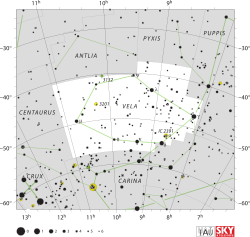Kappa Velorum
| Observation data Epoch J2000 Equinox J2000 | |
|---|---|
| Constellation | Vela |
| Right ascension | 09h 22m 06.81761s[1] |
| Declination | –55° 00′ 38.4017″[1] |
| Apparent magnitude (V) | 2.48[2] |
| Characteristics | |
| Spectral type | B2 IV[2] |
| U−B color index | –0.78[2] |
| B−V color index | –0.20[2] |
| Astrometry | |
| Radial velocity (Rv) | 21.9[3] km/s |
| Proper motion (μ) | RA: –11.40[1] mas/yr Dec.: +11.52[1] mas/yr |
| Parallax (π) | 5.70 ± 0.30 mas[1] |
| Distance | 570 ± 30 ly (175 ± 9 pc) |
| Orbit[4] | |
| Period (P) | 116.65 days |
| Eccentricity (e) | 0.19 |
| Semi-amplitude (K1) (primary) | 46.5 km/s |
| Other designations | |
Kappa Velorum (κ Vel, κ Velorum) is a binary star system in the southern constellation of Vela. It has the traditional name Markab,[5] from the Arabic مركب, markab meaning "something to ride". It is often spelled Markeb[7] to distinguish it from similarly named stars such as Alpha Pegasi. From parallax measurements, this system is located at a distance of roughly 572 light-years (175 parsecs) from the Earth. The apparent visual magnitude is 2.48,[2] making it readily visible to the naked eye in the southern hemisphere.
This is a spectroscopic binary system consisting of a pair of stars that complete an orbit around each other with a period of 116.65 days and an orbital eccentricity of 0.19. Because the individual stars have not been resolved, further details of the orbit have not yet been determined.[4] The combined stellar classification of the pair is B2 IV,[2] which matches the class of a B-type subgiant star that has exhausted the hydrogen at its core and begun to evolve into a giant. It has an estimated size of 6.9 times the Sun's radius.[8]
The star is only a couple of degrees from the south celestial pole of Mars, so it could therefore be considered the southern polar star of Mars.[citation needed] Due to precession of the equinoxes, it will be the closest bright star of note to the south celestial pole of Earth in the period surrounding 9000 AD.[citation needed]
Analysis of the spectrum for Kappa Velorum shows absorption line features from the interstellar medium between the Earth and the star. Long term observation of these features has shown variations, possibly caused by the transverse motion of an extended cloud extending 102–103 Astronomical Units.[9]
References
- ^ a b c d e van Leeuwen, F. (November 2007), "Validation of the new Hipparcos reduction", Astronomy and Astrophysics, 474 (2): 653–664, arXiv:0708.1752, Bibcode:2007A&A...474..653V, doi:10.1051/0004-6361:20078357
- ^ a b c d e f Denoyelle, J. (March 1977), "The spatial distribution of young stars in Vela (l = 257 to 284 )", Astronomy and Astrophysics, Supplement Series, 27: 343–365, Bibcode:1977A&AS...27..343D
- ^ Evans, D. S. (June 20–24, 1966), "The Revision of the General Catalogue of Radial Velocities", in Batten, Alan Henry; John Frederick (eds.), Determination of Radial Velocities and their Applications, Proceedings from IAU Symposium no. 30, University of Toronto: International Astronomical Union, Bibcode:1967IAUS...30...57E
- ^ a b Pourbaix, D.; et al. (September 2004), "SB9: The ninth catalogue of spectroscopic binary orbits", Astronomy and Astrophysics, 424: 727–732, arXiv:astro-ph/0406573, Bibcode:2004A&A...424..727P, doi:10.1051/0004-6361:20041213
- ^ a b Burnham, Robert (1978), Burnham's celestial handbook: an observer's guide to the universe beyond the solar system, Dover books explaining science, vol. 3 (2nd ed.), Courier Dover Publications, p. 2037, ISBN 0-486-23673-0, retrieved 2012-01-08
- ^ "kap Vel -- Spectroscopic binary", Centre de Données astronomiques de Strasbourg, retrieved 2012-01-08
- ^ Kunitzsch, P. (February 1986), "John of London and his Unknown Arabic Sources", Journal for the History of Astronomy, 17 (1): 51, Bibcode:1986JHA....17...51K
- ^ Pasinetti Fracassini, L. E.; et al. (February 2001), "Catalogue of Apparent Diameters and Absolute Radii of Stars (CADARS) - Third edition - Comments and statistics", Astronomy and Astrophysics, 367: 5211–524, arXiv:astro-ph/0012289, Bibcode:2001A&A...367..521P, doi:10.1051/0004-6361:20000451
- ^ Crawford, I. A. (August 2002), "Detection of CaI and CH absorption at the velocity of the variable interstellar component towards κ Velorum", Monthly Notices of the Royal Astronomical Society, 334 (2): L33–L37, Bibcode:2002MNRAS.334L..33C, doi:10.1046/j.1365-8711.2002.05730.x
External links
- "The path of the Southern Celestial Pole": The System of W. B. Yeats's A Vision [1] Diagram of the southern precession circle, showing Markeb as the South Pole Star in 9000 AD.
- Kaler, James B., "MARKEB (Kappa Velorum)", Stars, university of Illinois, retrieved 2012-01-08

